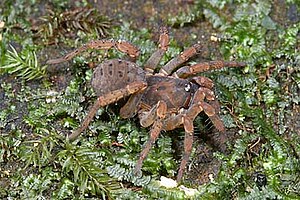Limb spiders
| Limb spiders | ||||||||||||
|---|---|---|---|---|---|---|---|---|---|---|---|---|

Female of the species Ryuthela tanikawai |
||||||||||||
| Systematics | ||||||||||||
|
||||||||||||
| Scientific name | ||||||||||||
| Mesothelae | ||||||||||||
| Pocock , 1892 |
Articulated spiders (Mesothelae or Liphistiomorpha) are a subordinate of the web spiders that is considered to be primeval . Among the recent spiders, only the family Liphistiidae Thorell , 1869 with 89 species in 5 genera, all of which can be found in Asia , belongs to it . The articulated abdomen, especially the number, position and morphology of the spinnerets are relics that can no longer be found in tarantulas and real spiders , also summarized as Opisthothelae . Substantial further differences in the internal and external anatomy support this thesis.
Segmentation as a relic of the evolution of the arachnids from the arthropods
While the abdomen of the Opisthothelae is no longer clearly structured, the structure of the articulated spiders is still clearly recognizable. It consists of the hard tergites of the back plate and the soft-skinned pleurs as a connection between the limbs. The structure also has a correspondence in the internal anatomy of animals.
structure
In contrast to the Opisthothelae, the back parts (tergites) of the abdominal segments are not significantly shortened. The second sternite is greatly enlarged. In its center is the epigastric furrow with the genital organs and, on its rear edge, the openings of the trachea and the book lungs . The third sternite covers another pair of fan tails , which are missing in the Opisthothelae.
The internal segmentation is most clearly reflected in the muscles of the abdomen (abdominal muscles). The dorsal (back) longitudinal muscles, which stretch from tergite to tergite and from sternite to sternite, are clearly segmented. Muscles stretch from tergite to sternite within the segments. The muscles attach to apodemas , which are clearly visible as small depressions on the back to the left and right of the midline. The dorsally lying heart also shows a segmental structure. In spiders with a transparent cuticle , the heart can be seen below the median line of the back.
Spinnerets
The spinnerets of the fourth and fifth Hinterleibssternit far forward on the ventral side of the abdomen, as the Tergites are not greatly shortened as in the Opisthothelae - a disadvantage by the spherically bulged abdomen and the conjoined sternites (belly panels) is compensated for the segments to some extent . Articulated spiders have 3 pairs of active and one pair of inactive spinnerets in the tenth and eleventh body segments (these are the fourth and fifth abdomen segments). The anterior middle pair is inactive and in the Opisthotelae regressed or transformed in various ways. In the tarantulas , both front pairs of the tenth segment are missing. In real spiders the outer pair of spinnerets of the 10th segment is present and active, but the inner (front) pair of spinnerets is transformed into a cribellum in the cribellate spiders and reduced to a colulus in the ecribellate spiders or completely absent.
Alternative system
Alternatively, the suborder Mesothelae is divided into the two families Liphistiidae and Heptathelidae with five genera and 80 species.
Fossil species
Despite the primeval shape and the assumed old age of the articulated spiders, only one fossil species has been convincingly assigned to the group to date: Palaeothele montceauensis (Selden, 1996) comes from the Carboniferous fossil deposit Montceau-les-Mines (Massif Central). The species was not assigned to any family, but does not belong to the recent Liphistiidae family due to the formation of the chelicerae .
literature
- Foelix, Rainer F. 1979. Spider Biology. Georg Thieme Verlag Stuttgart. ISBN 3-13-575801-X .
Individual evidence
- ↑ Joachim Haupt: The Mesothelae - a monograph of an exceptional group of spiders (Araneae: Mesothelae). In: Zoologica , 154, 2003. pp. 1–102, Schweizerbart ISSN 0044-5088 , ISBN 3-510-55041-2 ( synopsis and table of contents, language: English)
- ↑ Dunlop, JA, Penney, D., Jekel, D. (2015): A summary list of fossil spiders and their relatives. In World Spider Catalog. Natural History Museum Bern, online at http://wsc.nmbe.ch , version 15.5, accessed on February 19, 2015.
- ^ Paul Antony Selden (1996): First fossil mesothele spider, from the Carboniferous of France. Revue Suisse de Zoologie vol. hors series 2: 585-596.